Fenghuang ancient city A remarkable place to visit
Fenghuang Ancient city Overview
Fenghuang Ancient city, formerly known as Zhen’gan City, is located in the southwestern part of Xiangxi Tujia and Miao Autonomous Prefecture, Hunan Province. Covering an area of about 10 square kilometers, it is home to 28 ethnic groups, including Miao, Han, and Tujia, making it a typical area of ethnic diversity. Nestled at the southern end of the Wuling Mountains and the eastern edge of the Yunnan-Guizhou Plateau, the town derives its name from the green hills behind it, which resemble a phoenix spreading its wings.
Established in the 43rd year of Emperor Kangxi’s reign (1704), the ancient city still retains its original East and North gates. The town’s stone-paved streets, wooden stilted buildings along the river, and historic structures like the Chaoyang Palace, Ancient City Museum, Yang Family Ancestral Hall, Shen Congwen’s Former Residence, Xiong Xiling’s Former Residence, Tianwang Temple, Dacheng Hall, and Wanshou Palace all exude the unique charm of the ancient city.
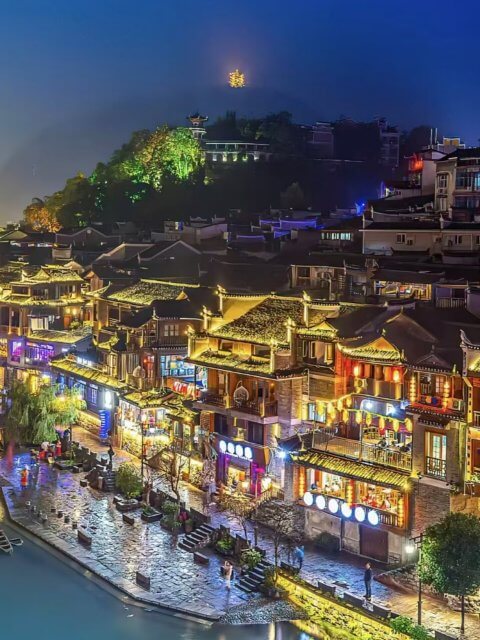
*Night View of Fenghuang Ancient city.

*Architectural Style of Fenghuang Ancient city.
Fenghuang ancient city has 68 historic buildings, 116 ancient sites, over 120 traditional residential houses from the Ming and Qing dynasties, and more than 30 temples, ancestral halls, and pavilions, making it the county with the most preserved historical architecture in Southwest China.
At the end of 2004, the town was listed as one of Hunan’s top ten cultural heritage sites. On May 25, 2006, Shen Congwen’s Former Residence was recognized as a national key cultural relic protection unit. On November 17, 2012, the town was included on the tentative list for China’s World Cultural Heritage as part of the Phoenix regional defense system. On February 6, 2024, Fenghuang ancient city, together with the Nanhua Mountain Shanfeng Cultural Scenic Area, was selected as a 5A national tourist attraction.
Geography🌏
The terrain of Fenghuang ancient city is complex. The eastern and southeastern parts are characterized by hilly valleys, forming the first tier of the landscape, mainly consisting of low mountains and high hills, along with some valleys and plains. The surface is rugged, with narrow valleys and steep slopes, generally below 500 meters in elevation.
The central area, stretching from the northeast to the southwest, forms the second tier, with elevations ranging from 500 to 800 meters. The northwestern region, characterized by middle-height mountains, constitutes the third tier, with elevations above 800 meters.
Climate🌥️
Fenghuang ancient city experiences a subtropical monsoon humid climate. It is warm and moist, with abundant rainfall and plenty of sunshine, featuring distinct seasons: cold winters, hot summers, warm springs, and cool autumns. The annual average temperature is 15.9°C, with the coldest months being January and February (average 2°C), and the hottest months being July through September (average 30°C).
The town receives an average annual rainfall of 1308.1 millimeters, with two significant rainy periods: spring (April-May) and the rainy season (June-July). Snowfall occurs in winter.

*Nanhua Gate of Fenghuang Ancient city.
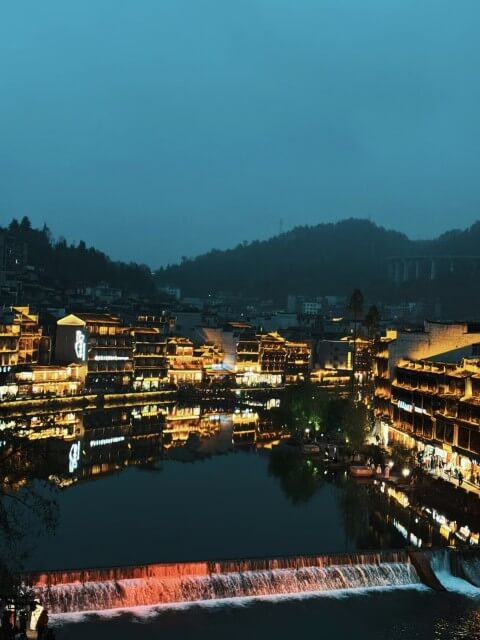
*Small Waterfall of Fenghuang Ancient city.
Hydrology🌊
The largest river in Fenghuang ancient city County is the Tuojiang River, a first-level tributary of the Wushui River, with two main sources: the north source, Wuchao River, originates from the southern canyon of Hekudu Mountain, characterized by rapids and torrents. The Tuojiang River runs from west to east across the central part of Phoenix County, passing through nine towns including La’ershan, Machong, Luochaojing, Duli, Nanhua Mountain, Tuojiang Town, Guanzhuang, Qiaoxikou, and Mujiangping, before merging with the Yuanshui River at Luxi County.
The main river stretches 131 kilometers, with 96.9 kilometers flowing within Phoenix County, covering a basin area of 732.42 square kilometers. The average annual flow rate is 11.89 cubic meters per second, with a natural drop of 533 meters.
Main Attractions
Tian Family Ancestral Hall
Located on Laoyingzhai Street on the north bank of the Tuojiang River, this ancestral hall was first built in 1837 by Tian Xingshu, a Miao general from Fenghuang ancient city who donated funds with his clansmen. During the early Republic of China, General Tian Yingzhao, son of Tian Xingshu, funded its completion. The hall is a distinct architectural complex with ethnic characteristics, featuring a grand gate, main hall, theater stage, and over 20 rooms. In front of the entrance, there are six fan-shaped steps made of red sandstone, leading to a spacious courtyard.
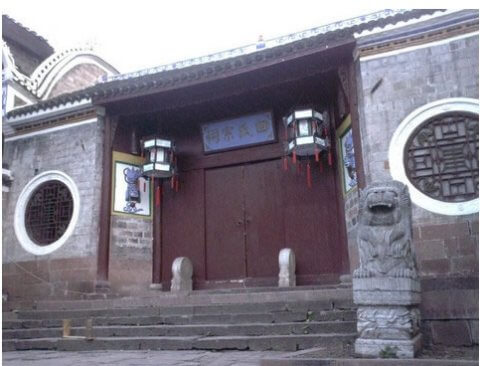
*Tian Family Ancestral Hall.
North Gate City Tower
The North Gate Tower, originally called “Bihui,” was first built during the Ming Dynasty. It is an iconic structure at the northern entrance of Fenghuang ancient city, constructed with local red sandstone and intricate craftsmanship. The gate features an arched design with iron-clad doors and heavy iron nails. The tower is built of blue bricks with a double-eave gable and wooden framework.

*North Gate City Tower.
Chen Dounan's Residence
Built in 1902, this residence is located in the heart of the ancient town between the East Gate Tower and Yang Family Ancestral Hall. It is a typical southern four-sided courtyard, known for its intricate design and high, secure walls. During the Republic of China, it served as a general’s residence and was used as a filming location for various famous movies.
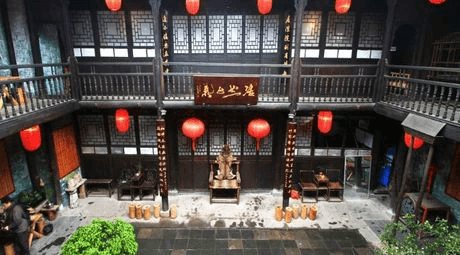
*Chen Dounan’s Residence.
Wenchang Pavilion Primary School
Founded in 1905 by Tian Xingkui, a local scholar who returned from Japan after studying, this school is the oldest in the region, embodying the spirit of education and enlightenment.
Stone-paved Old Street🧱
A narrow, less-than-5-meter-wide street paved with blue stones, this 3,000-meter-long stretch is the most bustling commercial street in Phoenix.
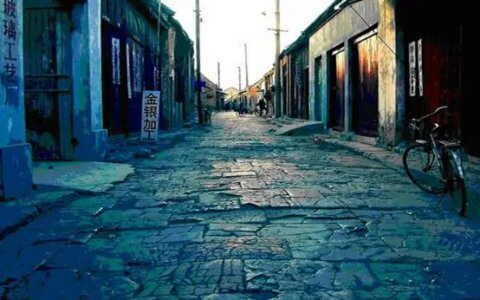
*Stone-paved Old Street.
Wanming Tower
Located on the north bank of the Tuojiang River, this hexagonal seven-story tower was built using a mix of blue bricks, sand, and concrete. Each corner of the tower features a wind chime, adding to its aesthetic charm.
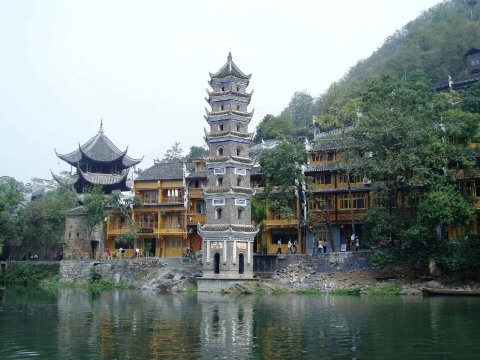
*Wanming Tower.
Chaoyang Palace
Also known as the Chen Family Ancestral Hall, Chaoyang Palace is one of the best-preserved ancestral halls in the town, featuring a grand theater stage and intricately carved structures. The hall was expanded in 1923 and is known for its classic southern architectural style.
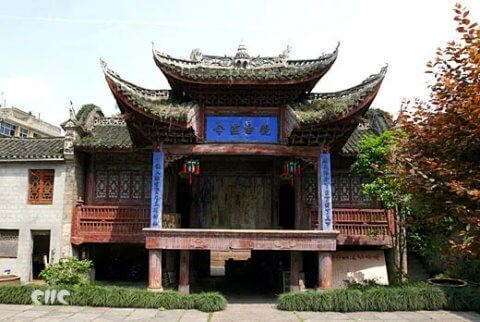
*Chaoyang Palace.
Wanshou Palace
Located outside the East Gate, Wanshou Palace is an architectural complex built during the Qianlong era (1755). It features a blend of Ming and Qing architectural styles and boasts intricate carvings and delicate structures.
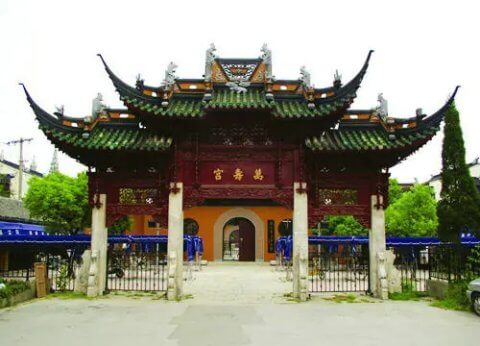
*Wanshou Palace.
Huangsiqiao Ancient Town
About 30 kilometers west of Phoenix, Huangsiqiao is one of the best-preserved ancient fortresses in China. Built in 687 AD, this fortress served as a strategic military outpost. The structure is built from blue limestone, known for its resilience.
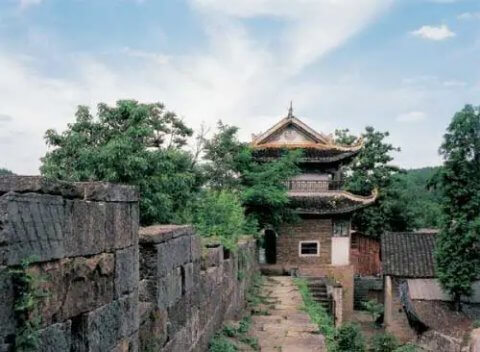
*Huangsiqiao Ancient Town.
Tuojiang River Jumping Stones
A series of red rectangular stepping stones, first laid out during the Tang Dynasty, that have become a popular scenic spot. These stones have been restored several times, providing a unique way for visitors to cross the river and admire the town’s scenery.
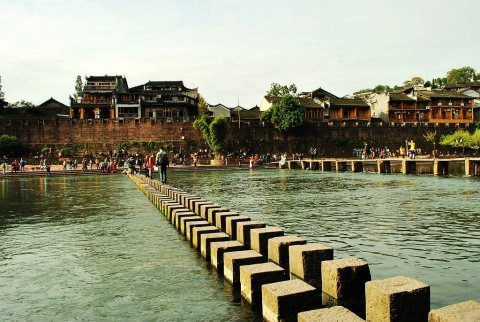
*Tuojiang River Jumping Stones.
China Miao Museum
Located in the mysterious “Miao King’s Palace” at Bagou Miao Village in Shanjiang Town, Fenghuang County, the China Miao Museum is the largest, most prestigious, and most extensive private museum dedicated to the Miao ethnic group in the country. It covers an area of 1,864 square meters with a building area of 1,200 square meters. The museum is divided into nine themed sections: Miao Farmhouse, Ancient Residence, Affluent Household, Warrior’s Home, Shaman’s Hut, Glimpses of Costumes, among others, along with the Miao Cultural Garden and living quarters.
It houses over 10,000 artifacts covering all aspects of Miao life, from clothing, food, and housing to daily activities. Focusing on family culture, the museum integrates history, ethnicity, and art, showcasing the development history of the Miao people over thousands of years—a journey of tireless labor and struggle. The museum paints a vivid picture of the mysterious, vibrant, and colorful culture of the Miao.
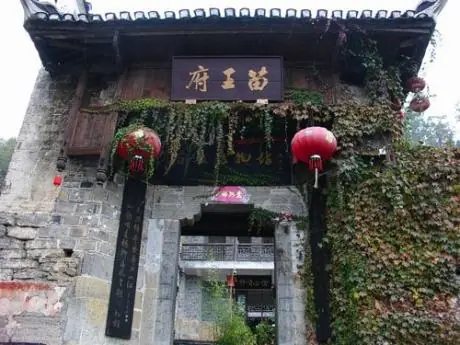
*China Miao Museum.
Qiliang Cave🕳️
Qiliang Cave is located north of the ancient town of Fenghuang, in Qiliangqiao Township, alongside the Jifeng Highway. It is a typical karst cave, encompassing mountains, rivers, gorges, rapids, cliffs, waterfalls, jungles, and villages. Inside, there are five main sections: “Ancient Battlefield,” “Gallery,” “Heaven,” “Dragon Palace,” and “Yin-Yang River.” The cave is known for its “strange, beautiful, serene, and rugged” features, earning the saying “Having seen Qiliang, there’s no need to see any other cave.”
The cave entrance is over 50 meters high and more than 20 meters wide, with a clear stream flowing gently through it. Colorful neon lights illuminate stalactites, stone curtains, and stone flowers, creating a stunning visual effect. The cave stretches for over twelve miles, taking more than three hours to traverse. Besides its mesmerizing scenery, Qiliang Cave also has a unique historical background and was once a filming location for the Hunan TV show Rose Date.
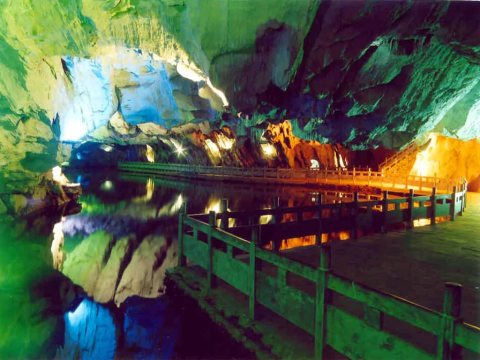
*Qiliang Cave.
Architecture Layout
The ancient town of Fenghuang covers an area of approximately 10 square kilometers. Within the town, there are streets paved with bluestone, wooden stilted houses along the river, and notable structures such as Chaoyang Palace, the Ancient Town Museum, Xiong Xiling’s Former Residence, Tianwang Temple, Dacheng Hall, Yang Family Ancestral Hall, Shen Congwen’s Former Residence, Wanshou Palace, among others.
There are over 120 traditional residential buildings from the Ming and Qing Dynasties and more than 30 temples, ancestral halls, and pavilions, making it the county with the most cultural relics and ancient architecture in Southwest China. Over 200 quaint stone-paved streets crisscross the town, with the main street, Huailong Pavilion Old Street, serving as the central axis.
The street connects numerous alleys, linking the entire town together. Huailong Pavilion Old Street, a line of bluestone paving, has been a bustling marketplace since ancient times. Fenghuang Ancient Town is divided into new and old parts. The old town is nestled by the water, with the gentle Tuo River flowing through it.
Red sandstone walls stand along the riverbank, with Nanhua Mountain as a backdrop to the ancient town tower, which still retains its Qing Dynasty iron gates, rusted and aged. The northern town gate tower, originally called “Bihui Gate,” stands over a broad stretch of the river, crossed by a narrow wooden bridge supported by stone pillars. Pedestrians must turn sideways when passing each other, as it was once the only exit from the town.
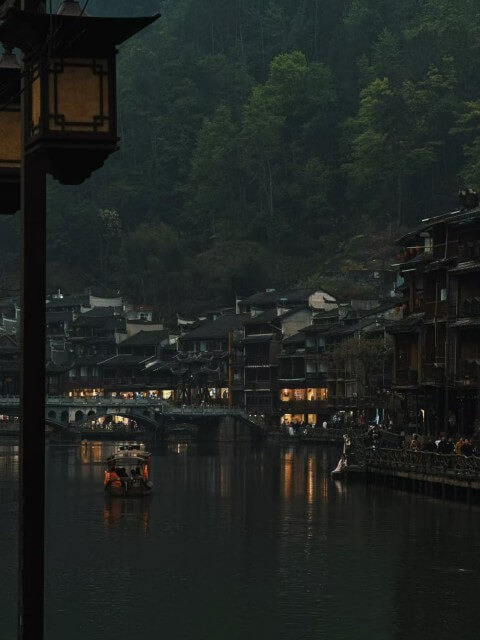
*Night View of Fenghuang Ancient Town.

*Dancing on Bamboo Rafts in Fenghuang Ancient Town.
Customs and Habits💃
Housing in Fenghuang Ancient Town is mostly wooden, with a mix of single-story and multi-story structures, as well as rectangular thatched houses. The local diet primarily consists of rice, supplemented by corn, wheat, and sweet potatoes. In some areas, the staple foods are corn, buckwheat, and potatoes. The traditional dress of Miao women varies greatly across regions. In most places, women wear large-collared, open-fronted short tops with pleated skirts of varying lengths—some reaching the feet, others stopping at the knees.
In some areas, women wear large-collared, right-overlapping tops with wide-legged trousers. Some tops are collarless, with broad floral trims on the sleeves and pant hems. Women wrap their heads with cloth scarves and accessorize with earrings, necklaces, bracelets, and other ornaments. Miao women’s headpieces are diverse; they often wear their hair in a bun at the top of the head, covered with headscarves in various styles—pointed, round, or wrapped around a frame to stand high above the head.
Their festive attire is uniquely characteristic of southeastern Guizhou, with silver ornaments stitched onto their clothes to create “silver clothes.” They also wear silver headpieces resembling bullhorns, extending over a foot high. Men’s clothing does not vary as much, typically consisting of large-collared or open-fronted short tops with long pants. In some regions, men wear linen short tops or long robes with cloaks woven with geometric patterns or woolen felt.
Living Habits
In the villages of Fenghuang Ancient Town, most of the houses face south and are mainly built as wooden stilted houses. Each stilted house has four pillars supporting it, with horizontal beams that hold up wooden floors, forming suspended attic spaces. Three sides of the house are surrounded by balconies, with railings carved with auspicious patterns such as the Chinese character for “joy,” and designs symbolizing good fortune.
Some even feature bat motifs, symbolizing happiness. Roofs often have posts that serve as observation points and clothes-drying areas. The roof ridges are designed in a Tai Chi pattern, with upturned eaves at the corners, creating a graceful, floating appearance. The roof ridges and eaves are built with gridded flower windows, embedded with glass, and painted with lacquer.
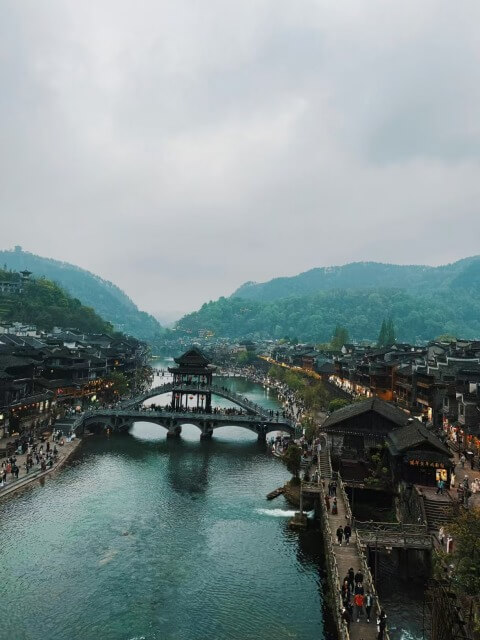
*Xueqiao morning in Fenghuang Ancient City.
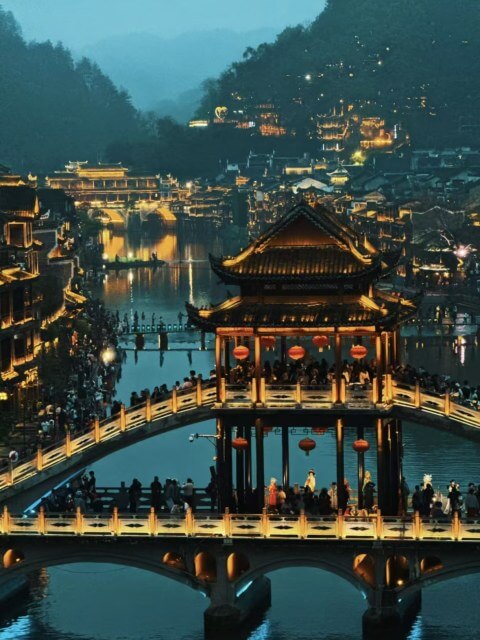
*Night View of Xueqiao in Fenghuang Ancient City.
Living Habits
First, the charm of Fenghuang lies in its holistic aesthetic, rather than in specific cultural relics or historical sites. It is not defined by precise historical or scientific value. Second, the cultural value of Fenghuang is reflected in its impact on modern people, offering a sense of primitiveness, simplicity, ecology, relaxation, and joy. These qualities align with an “anti-modernity” sentiment.
In contrast to the stress, pressure, and social alienation of modern life, Fenghuang provides a space for leisure (even laziness), release (through music and drink), and interaction (where strangers can quickly connect and engage without barriers). Third, the cultural essence of Fenghuang is deeply emotional, even to the point of being sentimental and dreamlike. The pursuit and fantasies of love permeate the atmosphere, becoming the overarching theme of the town.

694x469-300x203.png)